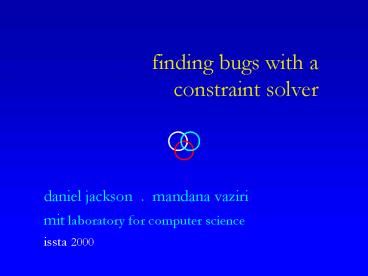finding bugs with a constraint solver - PowerPoint PPT Presentation
Title:
finding bugs with a constraint solver
Description:
finding bugs with a constraint solver. daniel jackson . mandana vaziri ... finding bugs in code efficiently. supports. specs. declarative specs ... – PowerPoint PPT presentation
Number of Views:62
Avg rating:3.0/5.0
Title: finding bugs with a constraint solver
1
finding bugs with a constraint solver
- daniel jackson . mandana vaziri
- mit laboratory for computer science
- issta 2000
2
overview
- goal
- finding bugs in code efficiently
- supports
- specs
- declarative specs
- relating different program points
- structural properties
- pre-defined
- partial code
- technique
- fully automatic
- errors missed, but no spurious errors
3
example linked list delete
- class List List next Val val
- void static delete (List p, Val v)
- List prev null
- while (p ! null)
- if (p.val v)
- prev.next p.next
- return
- else
- prev p
- p p.next
- ..
4
checking the spec
- user provides
- number of loop iterations
- number of objects in each class (scope)
- tool finds
- an execution of delete that contradicts the spec
5
counterexample to the spec
DomainsList L0Val V0 SetsE01
traversedE12 (null) E13 traversed E34
traversedp L0p1 L0prev L0prev1
(null)
prev2 (null)prev (null)v
V0 Relationsnext next1 val L0 -gt
V0next next1 val L0 -gt
V0 Skolem Constantsc L0
6
counterexample to the spec
- class List List next Val val
- void static delete (List p, Val v)
- List prev null
- while (p ! null)
- if (p.val v)
- prev.next p.next
- return
- else
- prev p
- p p.next
- ..
// spec no cell with value v after no c
p.next c.val v
7
more specs
- //no cells addedp.next in p.next
- //cells with value v removedp.next p.next
c c.val v - //no cells mutatedall c c.val c.val
- //no cycles introducedno c p.next c in
c.next ? no c p.next c in c.next
8
method
code
compiler
code constraint
iters.
code constraint all bounded executions in alloy
(first order logic)
9
method
code
compiler
code constraint
iters.
spec
?
final constraint
scope
alloy analyzer
counter
10
compiler
- steps
- encode state
- encode set of executions
- encoding set of executions
- construct computation graph from code
- label variables
- translate edges into alloy (encoding data flow)
- derive constraint from graph (encoding control
flow)
11
modelling state for delete
- class List List next Val val
- void static delete (List p, Val v)
- List prev null
- while (p ! null)
- if (p.val v)
- prev.next p.next
- return
- else
- prev p
- p p.next
domain List, Val state p List? v Val?
prev List? next List ? List? val List
? Val?
12
computation graph
- unrolled control flow graph
- node program point
- edge predicate elementary statement
- single entry, single exit
- no cycles
- loops unrolled
- a while (p) s b ? a if (p) s
assert !p b
13
computation graph for delete
- class List List next Val val
- void static delete (List p, Val v)
- List prev null
- while (p ! null)
- if (p.val v)
- prev.next p.next
- return
- else
- prev p
- p p.next
- ..
p p.next
14
variable labeling
- example
- x a x x b ? x1 a ? x2
x1 b - nodes hold labeling of each variable
- labels distinct on any given path
- same label for two connected nodes if no variable
update - minimize labels
15
variable labeling for delete
16
encoding data control flow
- data
- translate edge label to alloy formula
- control
- for each path
- conjoin formulas from edges
- combined paths
- disjoin path formulas
17
encoding data control for delete
0
0
no prev
1
some p
no p
3
?
p.val v
p.val ! v
6
4
prev1 p
prev1.next1 p.next
7
5
p1 p.next
return
8
no p2
2
18
experiments
- benchmark suite of procedures from (Sagiv et al)
- destructive update of linked lists
- specs
- null dereferences
- creation of cycles
- user-defined
- all anomalies found in scope of 1
- times less than 1 sec for scope 3
19
times for hardest check
- merge
- result.next p.next q.next
scope iters bits time
20
future work
- issues
- scalability (big procs, long chains)
- variety of datatypes
- approach
- partial analysis
- abstraction
- use specs instead of procedure calls
21
related work
- testing
- symbolic execution (King), PREfix (Pincus)
- model checking
- bounded model checking (Biere et al)
- Bandera project (Kansas State, Hawaii, UMass)
- Java Pathfinder (NASA Ames)
- SLAM project (Microsoft Research)
- ESC (Detlefs et al)
- parametric shape analysis (Sagiv et al)
22
comparison
- user does not provide inputs (testing)
- all possible inputs considered (PSA, testing)
- handles huge executions (testing, sym exec)
- addresses structure (MC, ESC, PREfix)
- handles declarative specs (MC, testing, sym exec,
PSA) - no spurious errors (PSA)
- no numbers (testing, sym exec, Prefix)
- no proof (PSA, ESC)
23
finding bugs with a constraint solver































